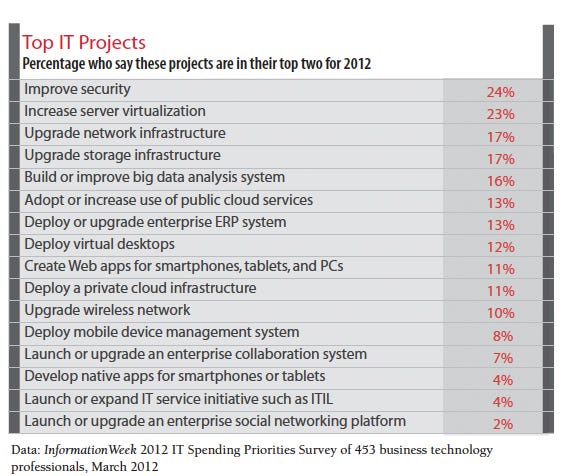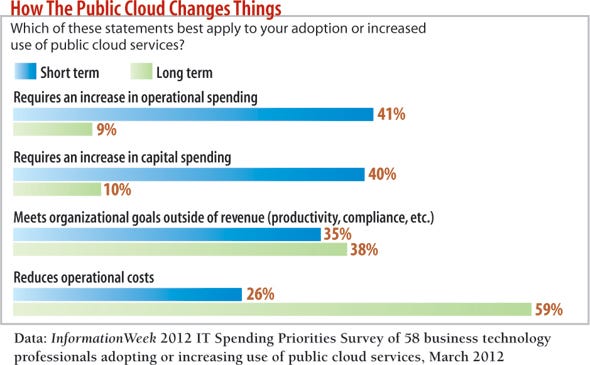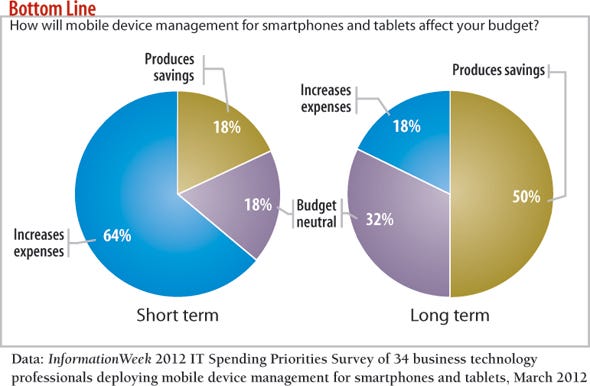Why IT Has A Credibility ProblemWhy IT Has A Credibility Problem
How can every project save money? Our first-ever IT Spending Priorities Survey shows that is IT's expectation, and that it needs to ground rosy projections in reality.

How are you feeling about your team's IT project portfolio? Optimistic? Will some of your top projects save the company money along the way? Will all of them? When it comes to budgeting and setting expectations, IT managers are an upbeat lot. That was the overarching finding of our IT Spending Priorities Survey, where 453 IT pros answered questions on their project portfolio and funding methodologies.
It's hard not to read the survey data and think of anything but unbridled optimism. But it's not grounded in reality.
Our survey shows that IT pros are looking to spend money they won't likely have. Furthermore, there's a disconnect between the business process innovation that business units want and the basics that IT is getting ready to deliver--and that's troubling.
Our IT Spending Priorities Survey was spawned from previous information research that showed IT teams typically are getting a slight bump in budget this year, but they're expecting to do far more projects than the anticipated increase should allow. So we decided to dig deeper into project expectations to see if we could determine how IT teams could pull off all those projects with such limited funds.
We came up with a list of 16 popular projects and asked IT pros to identify the two topping their to-do lists, telling us how they'd pay for them, and size up the short- and long-term impact on both IT and the company as a whole. What we got back was a whole lot more wishful thinking and a prioritized list that probably doesn't reflect the needs and desires of most line-of-business partners.
Everyone's going to spend in the short run but save in the long run, according to our research. And almost to a person, the data indicates that everyone is expecting to pay for IT projects with new budget allocations rather than savings or funds reassigned from other projects.
We ran comparisons of funding sources across all of the "top priority" projects listed by our survey respondents, and "new money" outweighed every other funding source. In fact, the intent to use new money dwarfs the intent to use savings and other funding sources. (See the full report for details.)
Most of our survey findings aren't going to fly with CEOs and CFOs. They've lived through plenty of IT projects that overpromised and underdelivered. There's the ERP system that took twice the planned time frame to implement while costing three times as much as budgeted. There's the software-as-a-service app no one used, or the one everyone did use that required a bunch of related apps to be customized and integrated.
IT executives who haul out the same old technique of promising savings when none is likely will end up with a credibility problem. Was all that Y2K spending really necessary? CFOs and CEOs have long memories, and they didn't see anyone's systems melting down on that Jan. 1.
Then there was the lofty claim of the dot-com era. "Brick and mortar is dead; everything's different now!" Sure, what's different is that customers have a new way to find and order your company's products, and while that's great, it's hardly the revolution promised by the bubblerazzi. Certainly, we could have figured that out without creating and then destroying a few trillion dollars of market cap and spending hundreds of billions of dollars in the process. Now it's virtualization, mobile apps, big data, cloud, and mobile device management (ranking 2, 5, 7, 8, and 10 in our survey's project list for 2012). Do you really want to stand in front of your CEO and claim that all of those initiatives will save the company money over the long run?
You might, and if you do, psychologists have a name for what you have: "unique invulnerability." It's the same phenomenon that causes 20-somethings to skip buying health insurance so they can go heli-skiing in the Grand Tetons--what could possibly go wrong? One study, by Neil Weinstein of Rutgers, showed that optimistic biases are more likely to emerge when an individual feels that the event is controllable and feels emotionally invested in the outcome. Both factors apply to most IT pros.
Therefore, someone in charge needs to apply some common sense and statistical analysis to IT budgeting.

Research: 2012 IT Spending Priorities Survey
 Our full report on IT spending is free with registration.
Our full report on IT spending is free with registration.
You'll get data on cost and savings expectations for more than 20 projects, from public and private clouds to BI to network, storage, and virtualization upgrades. Get This And All Our Reports
Future Shock
As for promises of long-term payback, the results to be realized "later" may well be when the employee who championed the project has switched jobs, and you're left holding the bag. We remember the promises of the network management systems of the 1990s, when network managers (whipped into a frenzy by system vendors) promised the sun, moon, and stars--only to find out that these systems were huge cash sinks that produced little more than low-cost packages such as WhatsUp Gold. Somehow, the network managers who recommended those systems had always managed to escape to other pastures.
Or what about that ATM infrastructure that got built by the only guy who really understood it, only to be ripped out when Fast Ethernet rose to dominance? Or that e-commerce site that was predicted to yield a huge payback but got nuked by Amazon's success?
Companies should always align these IT decisions with conservative principles of financial management: Underestimate revenues and overestimate costs. Think Enron and do the opposite. And don't factor in soft returns when you're talking about savings; stick to cash. If you promise head count savings, don't be surprised if the CFO asks for names of those you plan to let go. That'll put a sharp point on what he thinks real savings are.
The unbridled IT pro optimism is showing up even with something like mobile device management. In our survey, half of those respondents who plan to implement MDM say it will save them money over the long term. Really? We're talking about software that offers some policy enforcement and security measures on Android or iOS phones. Sure, there are some soft cost savings (MDM systems can be used to manage software rollouts), and the organizational benefits of enterprise apps on mobile devices are legion. But ... save money? Maybe if the alternative is sending IT-trained minders along with all mobile device users. Otherwise, it's just a new cost.
No matter how cynical an observer is, you can't deny that this is the year most IT organizations finally get to do some spending. Only 12% of the respondents to our survey are expecting IT budget cuts. Of those anticipating an increase, more than a quarter of them expect it to be in the 10% to 14% range, and 11% expect increases of more than 20%.
But for those anticipating a new binge of innovation, our data shows another sobering trend: Four out of our respondents' top five IT projects are all of the block-and-tackle variety, not transformative innovations.
Three of the top four priorities are improve security, upgrade storage, and upgrade networking--IT basics unlikely to get noticed by LOB execs. Even No. 2, virtualization, which 23% of our survey respondents consider a top priority, is now a basic activity.
What about hybrid clouds and cloud bursting, activities that promise to change the face of IT spending and human resourcing as we know it? Marquee names like Zynga and DreamWorks are pioneers, having optimized their infrastructure spending by balancing private and public cloud resources. Yet only 11% of our survey respondents identify private cloud as a top priority.
Which technology area has grabbed the attention of non-IT partners? We guarantee you: If we had surveyed CMOs and their direct reports instead of CIOs and their reports, social networking would be near the top of the priority list. Yet the social enterprise sits at the bottom of our survey respondents' list.
To be clear, we're not even talking about participating in external social media platforms such as Facebook and Twitter, or integrating current enterprise applications into them. Our survey question specifically said "launch/upgrade an enterprise social networking platform." And while we didn't offer an option for projects relating to external social media, no survey takers brought those up in the "Other" category.
No matter how you slice it, either social media's not on our respondents' radar or it's bundled in with the lowest of the low priority of deploying something like Yammer internally (a mere 2% of our respondents). Your CMO might not want Yammer, but she almost certainly is wigging out about the lack of social media integration with enterprise customer touch points, and surely your CEO has noticed how important social is to business growth. Is dead last really where it belongs on your IT priority list?
We may be blaming this disconnect on the victim. The reason for this focus-on-the-basics approach may simply be IT's long winter of budget cuts. A recent information column that previewed our findings posed the question: "Are these spending priorities coming from the standpoint that many IT teams are simply overtasked and underfunded?" One reader agreed passionately that organizations need the bulk of IT dollars to keep systems from completely failing. "I don't even understand why most systems haven't failed already," the reader said. "We are heading for a perfect storm and it is called 'I quit.'"

To Have And Have Not
Jason Hepner, IT manager for Sherwin-Williams Co., told us: "A lot of our focus is on keeping the infrastructure moving forward." He cites some of the company's early-mover practices (like adopting backup to disk six years ago), but on the whole, like many of our readers, his organization doesn't have a lot of people, time, or resources for "where the puck is going" types of projects.
Another IT pro told us that his organization's biggest project is replacing Lotus Notes with Exchange, plus updating Office to the 2010 version. Hardly transformative. But wait, it'll include SharePoint, so the company will be able to check that social networking box.
To be fair, this IT pro is probably in the same boat as the one who told us, "We have great needs and little control of planned resources." His IT budget had been cut by 30%. All of which is to say, if you're down in a hole and someone offers you any resource you want, you choose a ladder, not a flashlight, no matter how cool the flashlight is.
Where there's new money, there's room to maneuver. Sherwin-Williams' Hepner uses the tried and true innovation-via-new-business-project solution. That is, his LOB partners want a certain IT solution based on business goals, and "they have money to spend, and in implementing that solution, we may be able to innovate around that solution," Hepner says. If you have credibility with the particular business unit, more often than not the project sponsors will be glad to spend on a solid long-term approach.
This would be the "project-specific allocation from business units" data we collected about each of the top projects in our survey. On average, this LOB funding methodology is used 12% of the time, applied most often to big data and security improvements and less frequently to public cloud and storage infrastructure projects. That doesn't mean it will be impossible for you to fund other kinds of projects with LOB money. The project in question, or the benefit, just needs to make sense to the sponsor. Project sponsors sometimes have the luxury of looking at the big picture even if there's no big payback--something most IT leaders don't have right now.
As with any transformative IT initiative, early experimentation can head off much pain later, when the project isn't just interesting but imperative. If you're deploying large projects using transformative technologies such as private and hybrid cloud, business intelligence, and enterprise social, you're way ahead of the curve. If you're deploying smaller versions to get ready for the time that you'll need to deploy a larger one, good for you. If you wait until a project isn't innovative anymore, then you're just moving with the herd--safe, but not a differentiator for the business.
Pride And Prejudice
Take cloud as an example. You have "the data center union" protecting its turf: "Maybe if we upgrade the snot out of our infrastructure and spend on virtualization and SANs, the bosses won't think we need to spend on cloud." By the time cloud becomes as accepted as virtualization, you'll no longer have early-mover advantage.
The same risk looms if you fall behind rivals in social and big data. We're not saying you must implement all of these technologies at once or even enterprise-wide, but you must make some sort of allocation. Doing so in the course of well-funded business projects seems to be the strategy of choice.
IT spending is often a contentious trade-off, and nowhere is that more apparent than in security and social media.
At the extremes, security seeks to lock everything down; social, to open everything up. IT organizations must spend on both, yet security is the No. 1 priority in our survey, while social takes up the rear. As noted earlier, social networking is a top priority of marketing folks and the CEOs who love them. So it's not a question of "will you allow social?" but "how will you manage the risk?"
Much has been written about IT meeting business goals, but when it comes to their survival, IT organizations may be re-enacting The Hunger Games instead of Love Story--and that script won't have a happy ending. The smart money is on IT leaders who negotiate a project portfolio that passes muster with IT staffers and excites LOB colleagues.

Jonathan Feldman is director of information technology services for a city in North Carolina. His articles are at information.com/jonathanfeldman. Write to us at [email protected].

information: May 14, 2012 Issue
Download a free PDF of information magazine
(registration required)
About the Author
You May Also Like






